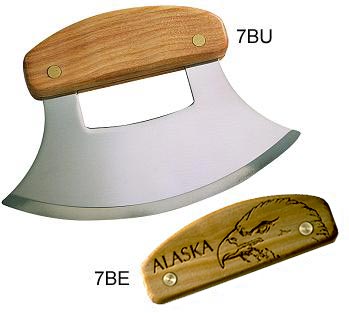Indicators on Bmerry Studio You Need To Know
Wiki Article
3 Easy Facts About Bmerry Studio Ulu Knives Explained
Table of ContentsSome Known Incorrect Statements About Alaskan Ulu Knives Bmerry Studio Ulu Knives - QuestionsAlaskan Ulu Knives Fundamentals ExplainedThe 2-Minute Rule for Bmerry Studio Ulu Knives
I will certainly think that the size and also angles will certainly be playing to the strengths of each of the grinds. Believe of exactly how a cavern curves in, or think "con-cavity".
A complete hollow work goes from the side completely approximately the spine. The Black Widow Caper imagined above is nearly a complete hollow work; you can see that a little the stock on the spinal column is still left unground. The hollow grind is prominent for both manufacturing as well as handmade blades.
Transforming wheel dimension can be pricey for manufacturers and handmade makers alike, which may restrict hollow ground designs to particular sizes, or sustain extra costs to make a specific layout. The hollow work is typically done on a slim blade, as well as then ground to have a thin edge. As I explained in my post on Blade Edges, thinner sides are a little weak yet they likewise cut better than thicker edges.
Facts About Bmerry Studio Revealed
If you integrate a hollow grind, a thin side, and also a nice deep stomach, it will certainly be just one of the most effective cutting blades you have ever had. One benefit of the hollow work is that the blade does not increase in thickness as dramatically as other grinds do. This suggests that as you sharpen the edge, it will remain almost as thin as when you first got your knife.The hollow grind does have a downside obviously. Given that there is much less product sustaining the side, it can chip or surrender with tough usage that make hollow grinds negative in large style blades like machetes. If you require your blade to be a supreme slicer, the hollow work will certainly perform admirably.
Hollow grinds prevail on hunting and also skinning blades for this factor. An additional blade that utilizes the hollow work is the straight razor. The exceptionally slim side you can attain with a hollow grind permits very easy press reducing with the straight razor.: Wonderful slicing ability, easy to sharpen, easier to manufacture (can be subjective).
: The edge can be vulnerable compared to various other grinds. No slicing. Grinding wheel costs could restrict blade design. The complete level grind is as it appears - the grind copulates below the back to the edge bevel in a level, direct slope. The level grind is one of one of the most flexible grinds.
An Unbiased View of Bmerry Studio Ulu Knives
Or it can be a balance in between the 2. A lot of level grinds are an equilibrium in between the two, though it will depend on the design. The full flat grind is thickest at the spine for toughness, yet tapers down right into a reasonably slim edge for outstanding slicing. Much more steel is removed from the sides, enabling for less complicated cutting and also allowing the blade to move via tools much easier.The level work's main bevel inclines linearly and gradually. This enables the full flat grind to travel through materials with more ease than other grinds that slope non-linearly (hollow), or at steeper angles (sabre). This is why the majority of kitchen area knives are flat ground - so they click here to read can pass through food conveniently without much resistance.
If someone says "sabre hollow ground" you understand the blade has a hollow grind that starts partway down the blade. The transition line in between the key bevel and the unground section of the blade is described as the Sabre Line. The sabre grind is used when the maker wants a stronger blade.
The sculpt work is not ground on one side at all. The knife envisioned my link above, and the account diagram photo to the left, are both sabre chisel grinds.
Examine This Report on Bmerry Studio Ulu Knives
A full carve work would have the bevel copulate up to the back (Alaskan Ulu Knives). The carve grind is easy to make, as you just need to grind one side, as well as you don't have to make the work symmetrical with the various other side. The carve work is likewise very easy to develop for the very same factor - there's just one side to hone (and after that strop off the burr).
The low sabre grind produces an obtuse main bevel angle, integrated with a useful site carve work, creates a very thick as well as strong edge.: Excellent strength, good slicing (depending upon angle), very easy to sharpen, can have terrific cutting capability (once again - angle).: Often located in choppers such as machetes or various other bushcraft blades.
Report this wiki page